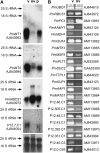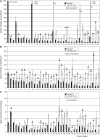Common plantain. A collection of expressed sequence tags from vascular tissue and a simple and efficient transformation method
- PMID: 17041024
- PMCID: PMC1676067
- DOI: 10.1104/pp.106.089169
Common plantain. A collection of expressed sequence tags from vascular tissue and a simple and efficient transformation method
Abstract
The vascular tissue of higher plants consists of specialized cells that differ from all other cells with respect to their shape and size, their organellar composition, their extracellular matrix, the type of their plasmodesmata, and their physiological functions. Intact and pure vascular tissue can be isolated easily and rapidly from leaf blades of common plantain (Plantago major), a plant that has been used repeatedly for molecular studies of phloem transport. Here, we present a transcriptome analysis based on 5,900 expressed sequence tags (ESTs) and 3,247 independent mRNAs from the Plantago vasculature. The vascular specificity of these ESTs was confirmed by the identification of well-known phloem or xylem marker genes. Moreover, reverse transcription-polymerase chain reaction, macroarray, and northern analyses revealed genes and metabolic pathways that had previously not been described to be vascular specific. Moreover, common plantain transformation was established and used to confirm the vascular specificity of a Plantago promoter-beta-glucuronidase construct in transgenic Plantago plants. Eventually, the applicability and usefulness of the obtained data were also demonstrated for other plant species. Reporter gene constructs generated with promoters from Arabidopsis (Arabidopsis thaliana) homologs of newly identified Plantago vascular ESTs revealed vascular specificity of these genes in Arabidopsis as well. The presented vascular ESTs and the newly developed transformation system represent an important tool for future studies of functional genomics in the common plantain vasculature.
Figures






Similar articles
-
Phloem-specific expression of Yang cycle genes and identification of novel Yang cycle enzymes in Plantago and Arabidopsis.Plant Cell. 2011 May;23(5):1904-19. doi: 10.1105/tpc.110.079657. Epub 2011 May 3. Plant Cell. 2011. PMID: 21540433 Free PMC article.
-
Differential expression of sucrose transporter and polyol transporter genes during maturation of common plantain companion cells.Plant Physiol. 2004 Jan;134(1):147-60. doi: 10.1104/pp.103.027136. Epub 2003 Nov 20. Plant Physiol. 2004. PMID: 14630956 Free PMC article.
-
Characterization of a novel plantain Asr gene, MpAsr, that is regulated in response to infection of Fusarium oxysporum f. sp. cubense and abiotic stresses.J Integr Plant Biol. 2010 Mar;52(3):315-23. doi: 10.1111/j.1744-7909.2010.00912.x. J Integr Plant Biol. 2010. PMID: 20377692
-
European consortia building integrated resources for Arabidopsis functional genomics.Curr Opin Plant Biol. 2003 Oct;6(5):426-9. doi: 10.1016/s1369-5266(03)00086-4. Curr Opin Plant Biol. 2003. PMID: 12972042 Review.
-
Plantago media L.-Explored and Potential Applications of an Underutilized Plant.Plants (Basel). 2021 Jan 30;10(2):265. doi: 10.3390/plants10020265. Plants (Basel). 2021. PMID: 33573139 Free PMC article. Review.
Cited by
-
Spatiotemporal profiling of starch biosynthesis and degradation in the developing barley grain.Plant Physiol. 2009 May;150(1):190-204. doi: 10.1104/pp.108.133520. Epub 2009 Mar 25. Plant Physiol. 2009. PMID: 19321714 Free PMC article.
-
The Glycine- and Proline-Rich Protein AtGPRP3 Negatively Regulates Plant Growth in Arabidopsis.Int J Mol Sci. 2020 Aug 26;21(17):6168. doi: 10.3390/ijms21176168. Int J Mol Sci. 2020. PMID: 32859078 Free PMC article.
-
Advancements in plant transformation: from traditional methods to cutting-edge techniques and emerging model species.Plant Cell Rep. 2024 Oct 29;43(11):273. doi: 10.1007/s00299-024-03359-9. Plant Cell Rep. 2024. PMID: 39467894 Review.
-
PlaMoM: a comprehensive database compiles plant mobile macromolecules.Nucleic Acids Res. 2017 Jan 4;45(D1):D1021-D1028. doi: 10.1093/nar/gkw988. Epub 2016 Oct 24. Nucleic Acids Res. 2017. PMID: 27924044 Free PMC article.
-
Tissue-specific transcriptomic profiling of Plantago major provides insights for the involvement of vasculature in phosphate deficiency responses.Mol Genet Genomics. 2019 Feb;294(1):159-175. doi: 10.1007/s00438-018-1496-4. Epub 2018 Sep 28. Mol Genet Genomics. 2019. PMID: 30267144
References
-
- Aitchitt M, Ainsworth CC, Thangavelu M (1993) A rapid and efficient method for the extraction of total DNA from mature leaves of the date palm (Phoenix dactylifera L.). Plant Mol Biol Rep 11: 317–319
-
- Asano T, Masumura T, Kusano H, Kikuchi S, Kurita A, Shimada H, Kadowaki K (2002) Construction of a specialized cDNA library from plant cells isolated by laser capture microdissection: toward comprehensive analysis of the genes expressed in the rice phloem. Plant J 32: 401–408 - PubMed
Publication types
MeSH terms
Substances
LinkOut - more resources
Full Text Sources
Other Literature Sources
Molecular Biology Databases

